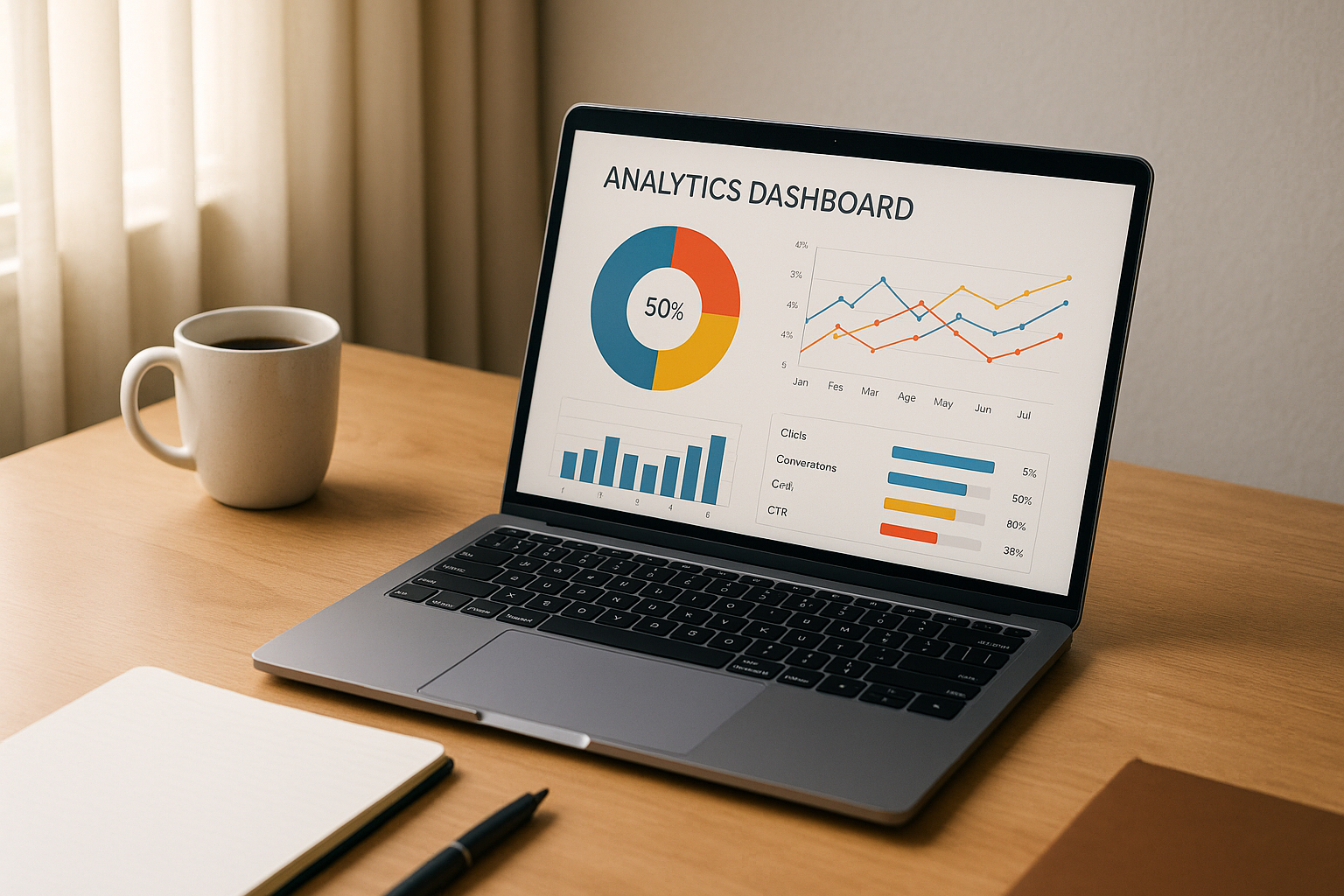Stop wasting money on ineffective ads. Here's how to optimize your PPC campaigns for higher ROI:
- Keyword Research: Use tools like Google Keyword Planner or SEMrush to find specific, high-converting keywords. Add negative keywords to avoid irrelevant clicks.
- Ad Copy & Landing Pages: Match ad copy to user intent, include strong CTAs, and ensure landing pages are fast and relevant.
- Bids & Budgets: Regularly adjust bids based on performance and focus budgets on top-performing campaigns.
- Performance Tracking: Set up conversion tracking and monitor key metrics like CTR, CPC, and Quality Score.
- Advanced Tactics: Use location targeting, mobile optimization, and retargeting to engage your audience effectively.
Example Impact: A small business improved CTR by 22% just by targeting niche keywords. Another cut CPC by 20% by refining their keyword match types.
Follow these steps to reduce costs, increase conversions, and make every click count.
Choosing and Managing Keywords
Research Keywords Thoroughly
The success of your PPC campaign starts with solid keyword research. Instead of targeting broad terms like "running shoes", focus on specific phrases like "best trail running shoes for beginners." These detailed searches make up 70% of web searches (Search Engine Journal, 2022) and often cost less while converting better .
Google Keyword Planner helps you find new keywords and shows you their search volume, competition, and costs. Tools like SEMrush and Ahrefs can expand your research even further.
Here's a real example: A small eco-friendly store used SEMrush to check what their competitors were doing. They spotted a gap - nobody was targeting "biodegradable packaging for small businesses." When they added these keywords to their ads, their click-through rate jumped by 18% in just two months.
Group Keywords by Theme
Want better ad performance at lower costs? Group similar keywords together. Google looks at how well your ads match user searches through their Quality Score system, which affects both your ad position and costs.
Think about it like organizing a store: You wouldn't mix yoga mats with dumbbells, right? The same goes for your keywords. Put "best yoga mats for beginners" and "non-slip yoga mats" in one group, and keep your weight training keywords separate. The numbers back this up - WordStream found that well-organized campaigns get 28% more clicks .
A digital marketing agency tried this approach. They split their broad "digital tools" group into specific ones like "SEO tools" and "social media tools." Their Quality Score went from 6 to 8, and they paid 15% less per click.
Use Negative Keywords Effectively
Want to stop wasting money on the wrong clicks? That's where negative keywords come in. They tell Google when NOT to show your ads, helping you focus on people who actually want what you're selling.
Picture a local bakery selling custom wedding cakes. They might block words like "cheap" or "DIY" to avoid showing ads to people looking for budget options or how-to guides.
Keep an eye on your Search Terms Report in Google Ads - it shows you what searches trigger your ads. Add irrelevant terms to your negative keyword list right away. Companies that do this well save up to 20% of their ad budget, according to WordStream's 2021 research .
Improving Ads and Landing Pages
Write Clear and Relevant Ads
Want better ad performance? Start by matching your ad copy to your target keywords. This simple step can boost your Quality Score and cut your costs. A design platform proved this works - they saw their click-through rate jump 20% in 2023 just by fine-tuning their message.
Don't forget about your audience's needs. Speak to their problems and offer solutions. Add some urgency with strong calls to action like "Start Your Free Trial Today" or "Get 50% Off Now". WordStream's 2022 study backs this up - ads with clear CTAs pulled in 35% higher conversion rates than those without .
Make Landing Pages User-Friendly
Great ads won't help if your landing page falls flat. Here's what makes landing pages work:
- Speed Matters: Google found pages that load in under 3 seconds see 53% fewer bounces
- Keep Your Promise: Your landing page should deliver exactly what your ad offered
- Make Action Easy: Put your CTA where users can't miss it
Refine Ads and Landing Pages Through Testing
A/B testing shows you what clicks with your audience. Try different headlines, descriptions, and page layouts. See what sticks.
Here's proof it works: One SaaS company stripped down their landing pages and made their CTAs pop. Result? 22% more conversions. But don't just test for fun - focus on changes that move your key metrics in the right direction.
Related video from YouTube
sbb-itb-89b8f36
Managing Bids and Budgets
Smart bid and budget management can make or break your PPC campaigns. Your approach should match your goals - whether you want more sales, better ROI, or increased brand visibility. Let's look at how to spend wisely and get the most from your PPC budget.
Adjust Bids Based on Results
Keep a close eye on your data and tweak your bids regularly. Here's what works:
Boost what's working: Put more money behind keywords that convert well. Here's proof it works: An e-commerce store bumped up bids by 20% on hot keywords like "best home treadmill" and saw sales jump 12%. On the flip flip side, a SaaS company cut bids by 30% on weak performers and saved $2,000 each month.
Use smart bidding tools: Google Ads offers automated options like Target CPA and Maximize Conversions to handle bidding for you. A travel agency tried Target ROAS and boosted their bookings by 25% in just three months.
Set Budgets and Focus on Top Performers
Smart budget management is just as crucial as bid adjustments. Here's how to make your money work harder:
Keep spending in check: Set clear budget limits to avoid surprises. Take this small jewelry business - they set a $100 daily cap on their best campaign and got 5x return on ad spend consistently.
Put your money where it works: A digital marketing agency stopped running ads with less than 1% CTR and moved that money to ads hitting 3% or better. Result? Their ROI shot up 18% in two weeks.
Stay flexible with your budget: PPC isn't "set and forget." A smart online retailer doubled down during their holiday sale, pumping more budget into campaigns that were already converting well. This move drove 40% more revenue during the promotion.
Your next move? Keep watching those numbers closely to make sure your adjustments are paying off.
Tracking Performance and Analyzing Data
Want to know if your PPC campaigns are actually working? Let's talk about how to track and analyze your campaigns to boost your ROI.
Set Up Conversion Tracking
Running PPC campaigns without tracking conversions is like driving with your eyes closed. Google Ads Conversion Tracker shows you exactly which actions bring in money. Here's a real example: when an online clothing store started tracking conversions, they found out that mobile users made 60% of their sales. After focusing on mobile, their conversion rate jumped by 25% .
To get started with tracking:
- Pick the actions that matter (sales, sign-ups, etc.)
- Set up tracking in Google Ads or Google Tag Manager
- Keep an eye on which campaigns drive results
Watch Key Metrics Closely
Four numbers can tell you if your PPC campaigns are hitting the mark: CTR, CPC, conversion rates, and quality scores.
Let's look at some real results:
A SaaS company added "Free Trial" to their headlines and saw their CTR shoot up from under 1% to 2.5%. A marketing agency cut their CPC by 20% just by switching from broad match to phrase match keywords.
Low conversion rates? Your landing pages might not match what your ads promise. And don't forget about quality scores - better scores mean lower costs and better ad spots. Focus on making your ads relevant and your landing pages top-notch.
Use Data to Improve Campaigns
Here's how smart companies use their data:
A fitness brand discovered that "Free Shipping" in their ads boosted sales, so they rolled it out across all campaigns. A travel agency found their sweet spot: ads targeting city folks aged 25-34 brought in 40% more ROI. By focusing on this group, they got 20% more bookings.
One home decor store took money from campaigns that weren't working and put it into ones that were - result? Their revenue jumped 25%.
The key is to keep watching your numbers and actually use what you learn to make your campaigns better.
Sources: Google Ads, Coupler.io Blog
Advanced Tips for Better Campaigns
Target by Location and Audience
Smart location and audience targeting can transform your PPC campaigns. Geographic targeting lets you show ads exactly where your customers are - whether that's specific regions, cities, or neighborhoods. A Chicago bakery proved this works: they got 35% more foot traffic by focusing ads within a 10-mile radius.
Want better results? Match your ads to the right people. A fitness app tried this by targeting young professionals interested in health - their conversion rate jumped 20%. The key? Know your audience's needs and habits, then create ads that speak directly to them.
Optimize for Mobile Users
Here's a fact: most people search on their phones. Your ads need to work perfectly on small screens. Take a page from Uber Eats' playbook - they use short, eye-catching ads with simple buttons like "Order Now" that work great on mobile.
Speed matters too. If your landing pages load in under three seconds, you'll see 27% more conversions and 53% fewer people leaving your site. Not sure how your pages perform? Try Google's Mobile-Friendly Test to spot and fix problems.
But what happens when visitors leave without buying? That's when retargeting steps in.
Use Reconnect with Retargeting
Think of retargeting as your second chance to make a sale. When someone visits your site but doesn't buy, you can bring them back with targeted ads that remind them what they're missing.
Here's how to do it right:
- Group visitors based on what they did on your site
- Test different ad designs and offers
- Keep track of what works and adjust as needed
Let's look at real results: A home decor store showed ads featuring items people had looked at before. Their sales went up 18% in just two months. For travel companies, this might mean showing flight deals to people who browsed vacations but didn't book. The key is making each ad feel personal to the viewer.
Conclusion: Steps to Improve PPC Campaigns
Want to boost your PPC campaign results? Here's what actually works.
Start with smart keyword research. Use Google Keyword Planner or SEMrush to find terms that match what your audience is searching for. Here's proof it works: A small eco-friendly e-commerce brand bumped up their CTR by 22% just by focusing on specific terms like "sustainable gifts" and "eco-friendly home goods."
Keep a close eye on your numbers and tweak your bids based on what converts. One SaaS company tried something clever - they increased bids on their best-performing keywords during peak hours. The result? A 15% jump in conversions.
Your ad copy makes or breaks your campaign. Just ask the local travel agency that saw their CTR shoot up by 30% after they started highlighting limited-time deals and personal experiences in their ads.
Make sure your landing pages match what you promise in your ads. Don't guess what works - test it. Run A/B tests to see what clicks with your audience. Track everything using Google Analytics or AgencyAnalytics - from your CTR to CPC and conversion rates.
Want to get started? Take a look at your current campaigns and pick the areas that need the most work. Remember: what gets measured gets improved. Keep testing, tracking, and tweaking until you hit your targets.


